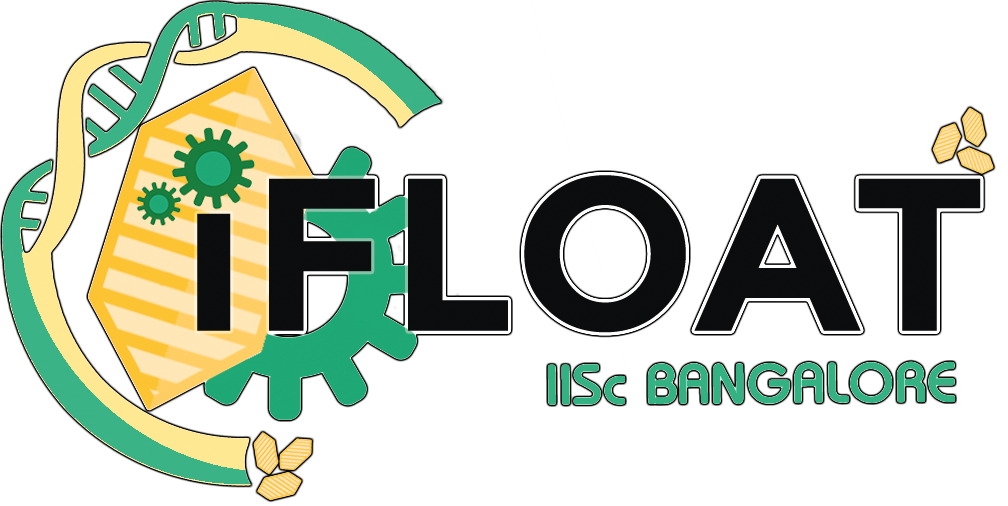
Visit to Biocon's R&D Facility
Near the end of June, we were planning on using gas vesicles to simplify recombinant protein purification. To understand this problem better — and direct our project focus toward solving it — we visited Biocon, India's largest pharmaceutical company.
Biocon's R&D park, located in Bangalore, hosted four members of our team who toured the facility and spoke to the Manager of the R&D division to understand how industrial recombinant protein synthesis works. Topics discussed ranged widely, from the choice of expression system — E. coli, Pichia pastoris, CHO cells — to the choice of growth medium for the microbes.

The most important takeaway from this industrial visit was the importance of scale: any novel idea that functions perfectly in a lab need not work even passably on an industrial scale! This visit to Biocon sparked our interest in industrial processes, leading to a more fruitful collaboration with industry that turned our project in an entirely different direction...
iGEM India Meet-Up @ IISER Pune
In mid-July, the iGEM 2017 India Meet-Up was organized by team IISER Pune, who invited the nine iGEM teams from India and team Peshawar from Pakistan (via videoconference) to a gathering of like-minded synthetic biologists, transcending all national boundaries to join the global community of science.
Several events were officially organized during this mini-Jamboree: including lectures from leading Indian biologists, an interactive discussion on Open Science and 20-minute presentations by each team — simulating the Giant Jamboree!

After each presentation was a lengthy Q&A session, where audience members posed questions and gave constructive criticism to each team. Our team members participated enthusiastically in these sessions, leaping to ask questions and discuss the intricacies of all the projects — a huge variety of synthetic biology applications were presented, and this led to new insights for every team that attended this event.
It wasn't all work and no play though — evenings were spent sampling local cuisines at an authentic Marathi restaurant and enjoying ice cream at Cream Stone as a group! The iGEM India Meet-Up is sure to become an annual tradition — who knows, we may host it next year!

The iGEM India Meet also made the community aspect of science very apparent to us: it gave us the opportunity to present our idea for a collaboration to many teams — to gather large amounts of data for our machine learning algorithm for analyzing haemocytometry images. Many hands make light work!
GCODe Mini Assembly
Our iGEM Hardware Outreach involved talking to professors, PhD students, undergraduates and random IISc visitors across fields ranging from optics to electronics to pathology. We learned many useful things, (some of which appear on our Hardware Evolution page) and understood what a difference GCODe would make.
Once we were done writing up the documentation for the GCODe Mini, we needed to know how easy it would be for someone else to build. Sure, the documentation looked complete to us, but that's because we already knew how to build it! There would definitely be lots of little things that seemed obvious to us, but would leave anyone else confused. There was only one way to find out - make someone build it! We invited Arpit Behera, a college freshman at IISc, to build the Mini from the instructions you see on the wiki.


We gave Arpit all the parts he needed, laser-cut and soldered, and a link to our Construction Manual.


He managed to build the GCODe Mini in less than two hours!

Although this was extremely gratifying, Arpit did have lots of feedback for us on where he found the manual difficult to understand, and which parts could be improved further. This helped us make the manual for the Mini much more comprehensive and user-friendly.
"Assembling a device of this complexity is always a tedious and frustrating task, but the Mini Construction Manual made it a lot easier. Getting to use the revised version would have been even better!" - Arpit
iGEM Dynamics: A Social Scientist's View
One evening in mid-August, a social scientist from IIT Delhi working on his PhD arrived on campus to discuss iGEM with us: having been exposed to iGEM through iGEM 2015's Team IISER Pune, Mahendra Shahare became fascinated with the concept of undergraduates working as a group on synthetic biology over the summer and presenting their results on an open, international platform. In fact, a section of his PhD thesis discusses iGEM as a vehicle to promote synthetic biology among young scientists around the world.
For over an hour, three members of our team discussed multiple facets of iGEM with him: the formation of our team, the development of our project, how we split up work among ourselves, our collaborations with other teams, our human practices activities, and how we interacted with our mentors and instructors.

The social aspects of science became quite apparent to us over the course of our discussion: iGEM had made us interact with so many groups of people — professors, mentors, instructors, industry, government officials, salesmen, HR representatives, sponsors, students, peers and the public — without us even realizing it!
Science is a social endeavor — more true today than ever, with the advent of the Information Age — and to truly develop as scientists, we must learn to embrace the notion that no man is an island. Our iGEM team, comprising students with different specialties and interests, is an excellent example of a social framework that allows science to progress one step further.












